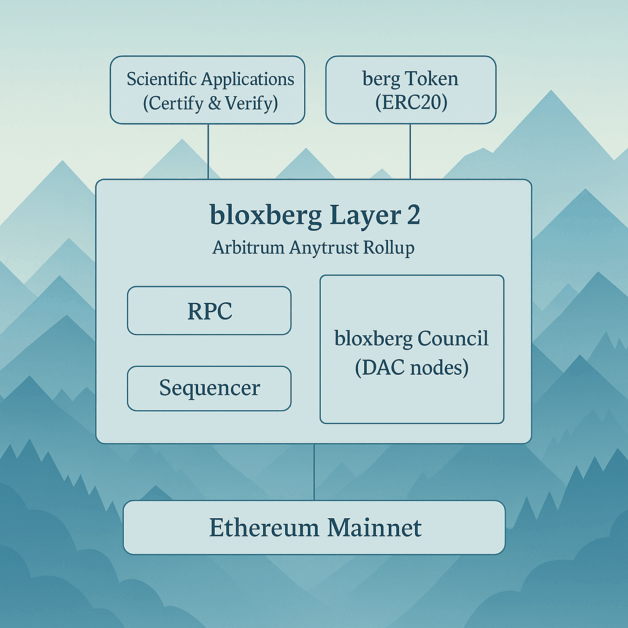Blockchain
We scale scientific trust – through Web3 infrastructure built to last.
In 2019, bloxberg 1.0 was initiated by the Max Planck Digital Library and launched as a public-permissioned Layer 1 blockchain operated by a global consortium of leading research institutions. Built on a Proof-of-Authority consensus model, it was designed to provide a trustworthy and transparent digital foundation for science — independent, sustainable, and openly accessible. Unlike anonymous mining networks, all validator nodes were and still are operated by publicly listed scientific organizations, ensuring full transparency and reputational accountability.
Today, bloxberg is preparing for its next phase: a transition towards a scalable Web3 architecture powered by Ethereum Layer 2 technologies. While Ethereum Layer 1 (Mainnet) serves as the highly secure base layer for anchoring transactions, Layer 2 solutions — such as Arbitrum AnyTrust Rollup — are being evaluated to enable faster processing, lower fees, and greater scalability without compromising on trust or security.
In this future model, the bloxberg Council takes on a central role. Its members — trusted research institutions and science-driven organizations — will operate Data Availability Committees (DACs) that capture and verify every transaction before submitting it to the rollup and finalizing it on Ethereum Layer 1. This architecture ensures that scientific organizations retain full control over data availability and validation, while benefiting from the performance and security guarantees of Ethereum’s decentralized backbone.
Importantly, bloxberg remains a green and resource-efficient blockchain: even in its new architecture, it consumes only a fraction of the energy required by traditional Proof-of-Work systems.
In short: bloxberg combines scientific trust and transparency with modern scalability and decentralization — bringing together the best of both worlds.
bloxberg’s Future Architecture on Ethereum Layer 2
A trust-preserving rollup design with DAC nodes, scientific applications, and Ethereum anchoring.

This simplified architecture illustrates bloxberg’s planned Layer 2 setup using Arbitrum AnyTrust Rollup. Scientific institutions — via the bloxberg Council — operate DAC nodes that validate and preserve transaction data before anchoring it to Ethereum Mainnet. The infrastructure connects directly to scientific applications and enables token-based services — combining performance with transparency and academic control.